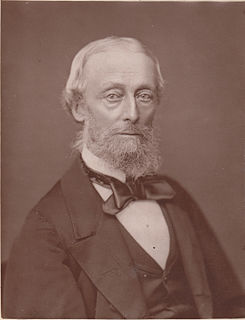Related Research Articles

Philately is the study of postage stamps and postal history. It also refers to the collection, appreciation and research activities on stamps and other philatelic products. Philately involves more than just stamp collecting or the study of postage; it is possible to be a philatelist without owning any stamps. For instance, the stamps being studied may be very rare or reside only in museums.

James Ludovic Lindsay, 26th Earl of Crawford and 9th Earl of Balcarres, FRS, FRAS, KT was a British astronomer, politician, ornithologist, bibliophile and philatelist. A member of the Royal Society, Crawford was elected president of the Royal Astronomical Society in 1878. He was a prominent Freemason, having been initiated into Isaac Newton University Lodge at the University of Cambridge in 1866.

The Royal Philatelic Society London (RPSL) is the oldest philatelic society in the world. It was founded on 10 April 1869 as The Philatelic Society, London. The society runs a postal museum, the Spear Museum of Philatelic History, at its headquarters in London.

Edward Benjamin Evans, a British army officer also known as "Major Evans", was a distinguished philatelist, stamp collector, and philatelic journalist. His philatelic specialization included Mauritius, the Confederate States of America, the Mulready envelopes, and the Indian feudatory states.

The Roll of Distinguished Philatelists (RDP) is a philatelic award of international scale, created by the Philatelic Congress of Great Britain in 1921. The Roll consists of five pieces of parchment to which the signatories add their names.

Percy George de Worms was an English aristocrat and philatelist.

Adelaide Lucy Fenton was an early female philatelist and philatelic journalist who was among the first to adopt a scientific approach to philately. Fenton has been called "...the first female philatelist of note".

Mount Brown was an early British philatelist and the compiler of only the second published stamp catalogue in the English language. Brown attended the City of London School and started to collect stamps in around 1860.
Gilbert "Gillie" Harrison was an English philatelist, and rugby union footballer who played in the 1870s and 1880s. He was one of the "Fathers of Philately" entered on the Roll of Distinguished Philatelists in 1921.

Charles William Viner A.M., Ph.D., was a British philatelist who was a founding member of the Philatelic Society, London, later to become the Royal Philatelic Society London, and who was present at the initial meeting of the society on 10 April 1869, and serving as its Secretary from 1871 to 1874. His obituary in The London Philatelist referred to him as the "Father of Philately" and elsewhere he was described as the vieille garde of philately having been actively collecting and writing about stamps since 1860. In 1921 he was entered on the Roll of Distinguished Philatelists as one of the founding Fathers of philately.

Friedrich Andreas Breitfuss was a Russian philatelist who was one of the "Founding fathers of Philately" entered on the Roll of Distinguished Philatelists in 1921.

The Reverend Francis John Stainforth was an early British philatelist, conchologist, and book collector. He was the Perpetual Curate of All Hallows Staining church in London, where Mount Brown compiled large parts of his catalogue. The church was believed to be the one mentioned by Charles Dickens in Dombey & Son.
William Hughes-Hughes D.L. was a barrister and founding member of The Philatelic Society, London.

William Edmund Image FRCS DL JP was an English surgeon and early philatelist.

Edward Loines Pemberton was a pioneering philatelist and stamp dealer who was a leading advocate of the scientific school of philately and a founding member of The Philatelic Society, London, now The Royal Philatelic Society London. Pemberton was entered on the Roll of Distinguished Philatelists in 1921 as one of the fathers of philately. He was born in New York City but educated in Britain by relatives when his parents died shortly after his birth. His son, Percival Loines Pemberton (1875-1949) was also an eminent philatelist.

William Amos Scarborough Westoby M.A. (1815–1899) was an English philatelist who was one of the "Fathers of Philately" entered on the Roll of Distinguished Philatelists in 1921. His obituary in The London Philatelist stated that he had "...fairly earned the title of the Grand Seigneur of Philately." By profession, Westoby was a barrister of Lincoln's Inn.
Hastings Elwin Wright was an English philatelist who was one of the "Fathers of Philately" entered on the Roll of Distinguished Philatelists in 1921. He was a civil engineer by profession.

William Wilmot Corfield was a British philatelist who was an important figure in Anglo-Indian philately. By his own account, he was an auditor by profession.

The Stamp-Collector's Magazine was one of the earliest philatelic magazines. It was published in twelve volumes between February 1863 and 1874.
Peter John Anderson(1853 – 12 May 1926) was the Librarian of the University of Aberdeen from 1894 and a noted philatelist who signed the Roll of Distinguished Philatelists in 1921. He was Secretary of the New Spalding Club and President of the Aberdeen and North of Scotland Philatelic Society. He bequeathed his collection of philatelic literature to the University.
References
- ↑ Worms, Percy de. The Royal Philatelic Society London 1869 - April 10th - 1919. Bath: 1919, p. 14.